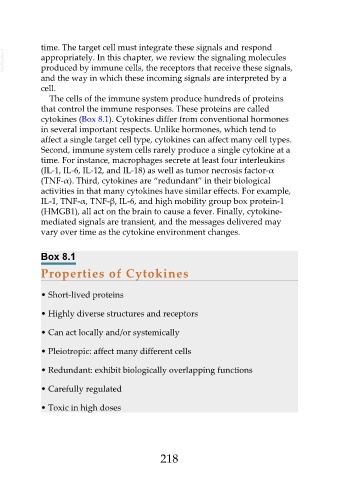Page 218 - Veterinary Immunology, 10th Edition
P. 218
time. The target cell must integrate these signals and respond
VetBooks.ir appropriately. In this chapter, we review the signaling molecules
produced by immune cells, the receptors that receive these signals,
and the way in which these incoming signals are interpreted by a
cell.
The cells of the immune system produce hundreds of proteins
that control the immune responses. These proteins are called
cytokines (Box 8.1). Cytokines differ from conventional hormones
in several important respects. Unlike hormones, which tend to
affect a single target cell type, cytokines can affect many cell types.
Second, immune system cells rarely produce a single cytokine at a
time. For instance, macrophages secrete at least four interleukins
(IL-1, IL-6, IL-12, and IL-18) as well as tumor necrosis factor-α
(TNF-α). Third, cytokines are “redundant” in their biological
activities in that many cytokines have similar effects. For example,
IL-1, TNF-α, TNF-β, IL-6, and high mobility group box protein-1
(HMGB1), all act on the brain to cause a fever. Finally, cytokine-
mediated signals are transient, and the messages delivered may
vary over time as the cytokine environment changes.
Box 8.1
Properties of Cytokines
• Short-lived proteins
• Highly diverse structures and receptors
• Can act locally and/or systemically
• Pleiotropic: affect many different cells
• Redundant: exhibit biologically overlapping functions
• Carefully regulated
• Toxic in high doses
218

